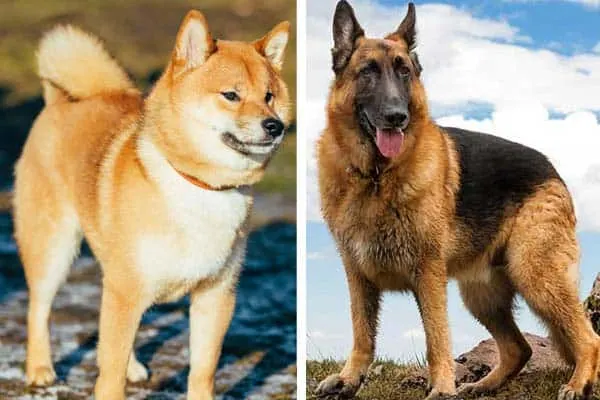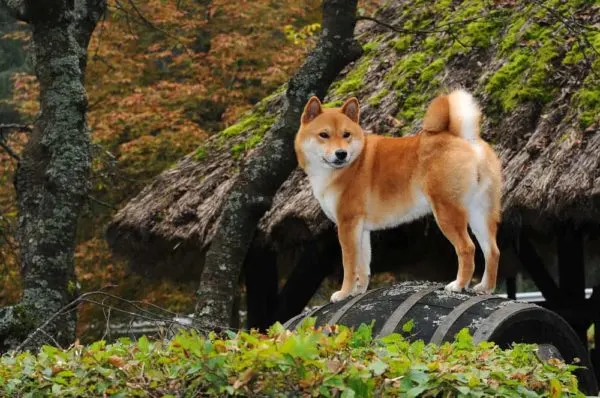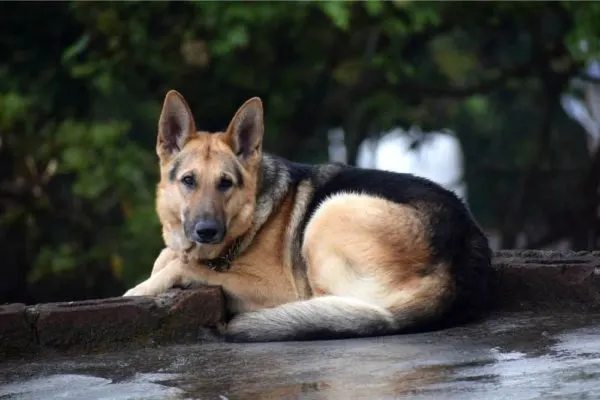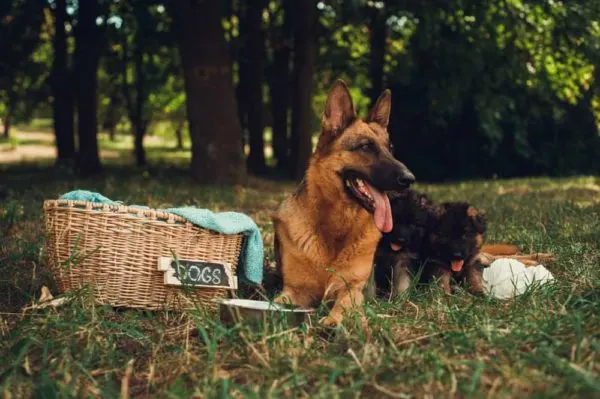Shiba Inu German Shepherd Mix: A Fairly High Energy & Loyal Companion
A designer dog, or hybrid breed dog, results from the purposeful mating of two different dog breeds with the aim of handpicking desired traits. The German Shepherd Shiba Inu Mix is a perfect example of this.
Typically, breeders mate two separate breeds for a specific reason. These dogs aren’t “mutts,” nor are they the result of an accidental breeding. Rather, they are bred to promote certain characteristics of the two parent breeds.
A German Shepherd and Shibu Inu Mix is a designer dog that is the result of mating these two breeds.

What is German Shepherd/Shiba Inu Mix?
This particular designer dog is so new to the list of hybrid breeds that there is no official name for the resulting pups; however, there are those who refer to the mix as Shepherd Inus.
Keep in mind that while designer dogs are not the result of accidental mating, the breed is not recognized by either the United Kennel Club or the American Kennel Club. There are those who do not agree with the practice of creating designer dog breeds.
They believe that unscrupulous breeders might throw together two unhealthy or otherwise not worthy of breeding dogs and demand a designer dog price for a low-quality pup.
One thing is certain, a Shiba Inu and German Shepherd mix is NOT one that is good for novice or beginner dog owners. They are working dogs, and they need an outlet for that desire to be busy.
Leery of strangers
Furthermore, both parent breeds are considered “aloof,” meaning they do not bond to just anyone. They may even be a little leery of people at times.
According to AKC, While both the Shiba Inu and the German Shepherd are great dog breeds, they need an experienced handler who understands their intelligence and can train them properly.
This also calls for an individual with some canine handling experience as neither the German Shepherd nor the Shiba Inu does well with negative reinforcement (punishment) when training goes awry.
The Shepherd Inu is likely to be a high-energy dog with a need to work. The designer dog will be very intelligent, and training may take some time under an experienced handler.
At times, the Shepherd Inu may be stubborn. They tend to have a high prey drive, and this can be off-putting to lesser experienced owners.
However, in the right hands, the Shepherd Inu rewards its human parents with love and loyalty that is second to none.
What is the background of the German Shepherd?
The German Shepherd Dog is a breed that originated in Europe in the 1800s. At the time, there were several wolf-like herding dogs that farmers referred to as shepherd dogs.
It was the goal of Captain Max von Stephanitz to develop one shepherd dog that was brave, loyal, high prey drive, and unmatched in its ability to herd and protect sheep.
Stephanitz was a career military leader, and upon his retirement from the German cavalry, the Captain focused his energy on breeding dogs. To do so, Stephanitz began studying the breeding techniques that the British used at the time.
In particular, he began to study the herding dogs native to that area. Noting their exceptional herding abilities, Stephanitz began to whittle down the attributes that he wished to see in the dog he was getting ready to develop.
Stephanitz attended many dog shows in Britain, and it was here that he determined the perfect shepherd dog would be brave, athletic, and highly intelligent.
However, he was disappointed to note that, no matter how many dogs show he attended, he never found one dog that possessed each of those qualities.
Adding wolves in the creation of German Shepherds
In 1899, Stephanitz observed a wolf-like dog at one of the many shows he attended. Stephanitz bought the dog and began using the male named Hektor Linksrhein to sire the ancestors of the German Shepherd dog we know today.
Although Stephanitz was on his journey to developing the perfect shepherding dog, the industrialization of Eastern Europe would curtail the need for shepherding dogs.
However, once again, the Captain’s military experience would influence his development of what we know today as the German Shepherd Dog.
Hektor’s descendants were strong, intelligent, and highly trainable. In fact, they loved to work! Stephanitz began pitching the dogs to the German government for use as police or military dogs.
During World War I, Hektor’s descendants served as messengers, supply carrying dogs, rescue workers, guards, and as assistants to Red Cross workers.
American soldiers who served in Germany took notice of the great work the German Shepherd Dog performed, and many of them brought back German Shepherd pups from Europe.
One highly notable pup was a five-day-old puppy that a soldier spied in the remains of a bombed kennel in France.
The American corporal took the puppy back home to the United States, and this pup would become famous. He would become known as Rin Tin Tin.
The retired Captain von Stephanitz did not back away from the breed even after it became popular across Europe and the United States.
He became alarmed as he noticed that many German Shepherd pups were developing a poor disposition and they suffered from tooth decay as well as hip dysplasia. To combat this, von Stephanitz insisted upon a new standard of breeding.
All breeders must use breeding dogs that were all of the following: intelligent, of good temper, healthy, and athletic.
Today, German Shepherds are often working dogs. They assist the military and police on dangerous missions, and they also serve as seeing-eye dogs.
They can also be general service dogs (meaning they may be therapy dogs or otherwise working dogs). Some German Shepherds are family dogs as well. In fact, they remain some of the most popular dogs in the United States and Europe.
What About the Shiba Inu?
The Shiba Inu is a Japanese hunting dog that was originally bred to hunt small game or flush out birds. Today, the Shiba Inu is a companion dog, but he never forgets the hunting heritage that is in his DNA.
The Shiba Inu is one of six dogs native to Japan. He is described as having cat-like agility, and he is definitely not a dog for a novice pet owner. Highly intelligent, the Shiba Inu is very trainable, but only through patience and positive reinforcement.
There is no exact date as to when the Shiba Inu was developed. All that is known about the history of the dog is that he is one of the original Japanese native dogs and that World War II nearly spelled extinction for the breed.
Many Shiba Inus died as a result of Allied bomb raids; those that did not perish in this manner were often subject to illness from distemper.
The bulk of dogs that did survive World War II lived in the remote countryside. Breed enthusiasts created breeding programs and brought in many of these dogs from the country to re-establish the breed.
The first Shiba Inu came to the United States in 1954. Much like the German Shepherd, the Shiba Inu was brought to America by a former soldier.
It was 1979 before the first American litter of Shiba Inu puppies was born; in fact, there is little documentation about Shiba Inus in the United States between 1954 and 1979 when said puppies were born.
The American Kennel Club began recognizing the breed in 1993 as a part of the “Miscellaneous Class” of dogs. In 1997, the Shiba Inu was re-classified as a part of the Non-sporting Group.
Brief Overview of the Shepherd Inu
The Shepherd Inu will be a medium-sized dog with a fairly high energy level. The Shepherd Inu cannot be left to its own devices in the backyard; this dog will be miserable with no work to do.
They thrive on working, and they will need a fairly great amount of exercise daily to keep the Shepherd Inu happy.
The Shepherd Inu is protective and fiercely loyal to family members, but they are often aloof around strangers. However, those who come around the family regularly will often be recognized by the Shepherd Inu and will not be seen as a threat.
Shepherd Inus are never lap dogs, and they do not require a great amount of attention. However, this does not mean that the Shepherd Inu can be ignored! Leave him alone a great deal of time, and you’ll have an unhappy dog.
The Shepherd Inu will typically have a high prey drive. This means you’ll need to begin training early, and repeat lessons often.
This designer dog is a great pup to add to the family, but only if you are willing to provide the daily exercise the dog needs.

































